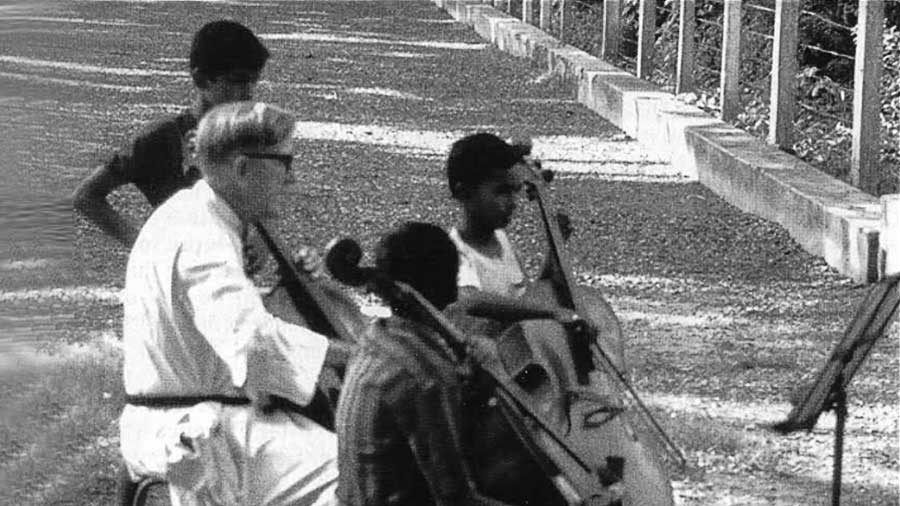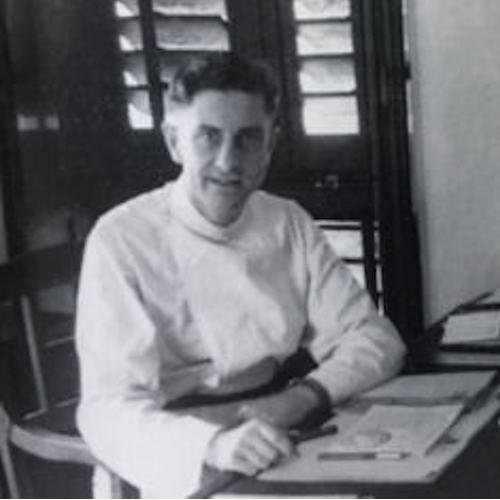The Cellist Priest: Fr. Theodore Mathieson (1913-1994)

Some months ago, I wrote a tribute column to the great Bengali film-maker Satyajit Ray (whose birth centenary we celebrate this year) and his film music. But a more recent article in the Kolkata press (Telegraph India) reminded me of another aspect of that music that I didn’t touch upon. If Ray’s film scores have a full-bodied string sound, a lot of the credit goes to an unlikely source: an Anglican priest from Chingford, Essex. At a time particularly in the wake of Fr. Stan Swamy’s institutional murder, when right-wing mouthpieces do their best to malign the work of Christian institutions, it comes as a refreshing surprise when at least a few sections of our media are able to highlight the good that they do.
The Oxford Mission was founded in Calcutta in 1880 in response to an appeal by the city’s Bishop Johnson to the University of Oxford for young men to come out to India to work with the poor. The Anglican Brotherhood worked among the lepers and the poorest of the poor and took vows of poverty, chastity and obedience.

Fr. Theodore Mathieson came to Calcutta in December 1946, perhaps not the best time for a British citizen to arrive, with Indian independence just months away. There was already a music programme “of a high standard” started earlier in 1924 by one Fr. Douglass for the boys at the Oxford Mission. Fr. Mathieson was an accomplished cellist himself, and immersed himself in the music education programme with enthusiasm.
Over the many decades that followed, Fr. Mathieson further strengthened the pedagogical foundation that formed the life-blood of Western classical music and indeed any string-playing endeavour in the city. Before long, Fr. Mathieson’s ‘boys’ could be found everywhere music was being made, from the Calcutta Youth Orchestra, Calcutta Chamber Orchestra, Navy Band, Calcutta Symphony Orchestra, and film recording studios.
Abraham Mazumdar, now 63, began learning the violin from Fr. Mathieson when he was eight. He was given a choice from any of the stringed instrument family (violin, viola, cello, double-bass); he chose violin. His later education was at the hands of a teacher Ananta Makhal, who taught all the stringed instruments, and must have been trained to do so by Fr. Mathieson.
Watching Mazumdar’s video testimonial, there were several learning points for me, invested through Child’s Play in music education for disadvantaged children myself, and some parallels with what we do. The accompanying picture of Fr. Mathieson teaching cello out in the open reminded me of our own al fresco lessons (out of necessity, due to space issues), which would cause much turning of heads from passersby.
I’ve been to Kolkata and played alongside musicians who can trace their pedagogical lineage in some shape or form to Fr. Mathieson. His name is uttered reverentially in Kolkata’s music circuit. These musicians are today to be found all over the country and the world.
As Mazumdar tells it, as soon as a child could play scales competently, he was inducted into the school orchestra, something Mazumdar was impatient to do. We see this same yearning among children across the socio-economic spectrum to join an ensemble, to be part of something bigger than playing by themselves.
As a conductor, Fr. Mathieson could communicate his intentions non-verbally to the orchestra, Maumdar says.
When he did speak to them individually, he’d say, “Play from your soul!” whose meaning initially baffled the young Mazumdar. Today Mazumdar gives his students the same advice. “You learn music to give joy to others, and that was THE lesson I got from Fr. Mathieson. If I hadn’t met Fr. Mathieson, I wouldn’t have known all this beautiful music… Bach, Mozart, Beethoven, Tchaikovsky etc.”
Mazumdar describes being taken for month-long residential orchestra camps to destinations like St Paul’s School Darjeeling in the summer holidays. It is something we at Child’s Play would love to do when conditions permit. Although we’ve had orchestra summer camps for several years before the pandemic, they’ve not been residential or as lengthy. Goa is an ideal destination for orchestra camp, and can easily be a hub for such music education events.
Mazumdar adds, “Fr. Mathieson never thought of music in competitive terms, and therefore never encouraged us to go for music competitions or exams.” Mazumdar and his young peers found that strange then, believing in the Indian notion of certificates and qualifications as a pre-requisite for future gainful employment. But Mathieson’s dream was larger, more egalitarian and holistic. He knew well that not every music-learning child would become, or want to become, a musician later in life. So he wanted to impart music to as many as possible, not focus on just a few. Those who did show the inclination and potential for further music education (such as Mazumdar) received encouragement and financial support. He also exhorted his students to become the next cohort of teachers for future generations. Mazumdar took that advice to heart, and began his own music academy in Kolkata.
But the poster boy for Fr. Mathieson’s story has to be Anup Kumar Biswas, a world-renowned cellist today, whose recitals many of you will remember here in Goa some decades ago. He was an orphan whose potential was spotted early by Fr. Mathieson. “At the age of ten the cello changed my life,” he reminisced in a 2017 interview. His progression on the instrument was remarkable: at 16, he had gained admission first to London’s Royal Academy of Music and later the Royal College of Music. He studied with the world’s great cellists including Pierre Fournier and Jacqueline du Pré and is a respected performer in his own right. In 1994, he founded the Mathieson Music School, giving both musical and general education to disadvantaged children and helping them find employment later in life.
In 1981, Satyajit Ray was so impressed with Biswas’ cello performance at a recital that he purchased tickets for all the Oxford Mission students for his latest film.
Fr. Mathieson corresponded often from Calcutta with his family in England, and his letters, full of humour and insight are compiled into a book, “Theodore: letters from the Oxford Mission in India 1946-1993.” One of those letters from 1992 ends thus: “I listened to a tape made by our most famous Film Director – Satyajit Ray – who died recently, in which he said there is no difficulty in getting a supply of cellists in Calcutta, because the Oxford Mission produces plenty!”
We rightly celebrate Ray’s birth centenary this year. But Fr. Mathieson’s centenary in 2013 slipped by unnoticed, and his life’s work is largely unknown. The next time we watch Ray’s marvelous films, let’s listen with fresh ears to the soundtrack and applaud the music-loving Anglican priest who raised the bar for music-making in India and touched so many lives in such profound ways that perhaps he himself may never have imagined.
This article first appeared in The Navhind Times, Goa, India.





